
Thank you for visiting HOJO website. If you have any enquiry, please feel free to get in touch with us at
▼ Akira Hojo
▼ Hojo Newsletter
▼ HOJO FACEBOOK





HOME > Green Tea > Taiping Houkui
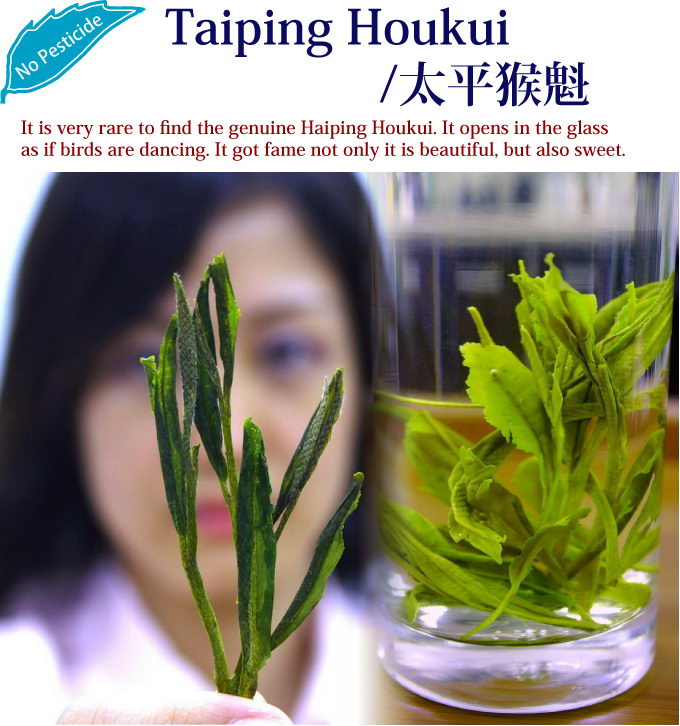

Taiping Houkui (太平猴魁) has been selected as one of the Top Ten Teas in China. It is also a historically reputed tea since Qing Dynasty. It is produced from the Hou-keng areas (猴坑) at Huang-shan City (黄山市) of Anhui Province (安徽省).
Its leaf measures up to 60 mm; it is the largest sized leaf tea among the famous green teas. But surprisingly its size does not affect its delicate orchid fragrance with a mellow taste which lasts up to four brewing. In a glass, the leaf gracefully sways in the water which is described as the ‘Phoenix dances’.
In harvesting, every single twig which contains one bud and 3-4 leaves is plucked from tea tree. Subsequently it is meticulously re-plucked again at factory, where only one bud and two leaves remains, and other leaves are removed. This is the expertise and effort of manufacturer to preserve the tea leaves to ensure it to be in good shape until it is sent for processing.
Unlike most the green teas, Taiping Houkui does not undergo any rolling process. It is dried at once using a series of bamboo baskets heated at various temperatures. Inactivation of enzyme as well as enhancement of flavor takes place during these unique processes. Eventually, Taiping Houkui preserves its most natural shape, and the end product presents an exclusive characteristics. It has been used as one of the gift teas for diplomatic mission in China.
The real Taiping Houkui is rare as the production area is limited and there is a great demand for it. Thus it is difficult to obtain the authentic product, even in China.
HOJO particularly focus on Taiping Houkui which is produced from Hou-keng areas, where it has the ideal environment for growing top quality tea. In addition, we choose the non-pesticide tea as our criteria to ensure the highest safety standard of tea.
The Taiping Houkui is a China historical tea, it was produced as early as the Qing Dynasty at Anhui Province. It belongs to the rare group of tea, i.e., the sharp-shaped green tea (尖茶 Jian-cha). Its name refers to its shape: the pointed shape at the sides, the top and the end. The name Houkui (猴魁) means the Monkey King. Legend has it the Taiping Houkui tea tree was transformed from the monkey king that fell sick and died at the mountain area after loosing his son. A farmer came across this sad incident and buried his body right there. The next year, some tea trees began to grow at the place where his body was buried. It is believed that the tea trees were transformed from monkey king who gave it to the farmer as a token of appreciation for his kind deed. The farmer took good care of the tea tree, harvested the leaves and made it into this sharp-shaped tea. From then onwards, its unique flavor and taste gained much attention from the villages and became popular and famous.
Another record claimed that the production of the sharp-shaped tea (尖茶Jian-cha) bloomed during the Qing Dynasty. Taiping County (太平县 Tai-ping Xian) was one of the most productive areas in Anhui, that’s where the name Taiping is derived from. At Taiping County, there was a tea center where people sent their tea product for commercial trade. In the past, people used to produce Jian-cha which contains various numbers of leaves, and usually the tea contained a lot of matured leaves.
In the latter stage, some people started to select the dry leaf which contains only one bud with 1-2 leaves from the finished product, and sold it. This selected tea was highly appreciated and can be sold at much higher price. This inspired a farmer named Wong Kui-Cheng (王魁成) who started to produce this tea using fresh leaves which contained one bud with 1-2 leaves rather than selecting the dry leaf after the process. It was very successful and the tea produced was highly praised and sought after. As his tea was the best quality among the sharp-shaped green tea produced (魁首 Kui-shou), and his name is Kui-Cheng (魁成), furthermore it was produced at Hou-keng (猴坑) area, it was only logical that the name Taiping Houkui was begotten.
1900: This tea was first brought to the exhibition held by the agricultural and commercial department at Nanjing (南京); it was highly praised and became a renowned tea to the public.
1915: In order to celebrate the launching of Panama Canal, the United State of America held the unprecedented World Expo at Panama. China introduced and contested in several teas, including Taiping Houkui, Keemun Black Tea, etc. Taiping Houkui won a gold prize.
1916: It was granted another gold prize during the commercial expo at Jiangsu Province (江苏省).
1955: It was selected as one of the Top Ten teas in China.
1988: At the First China Food Expo, it won a gold prize.
2004: It was given the highest honor prize (The King of Tea 茶王, Cha-wang) at the China International Tea Expo held at Wu Lake (芜湖 Wu Hu) at Anhui Province.
By far, the Taiping Houkui has been one of the sought after gift teas presented to foreign visiting dignitaries to China.
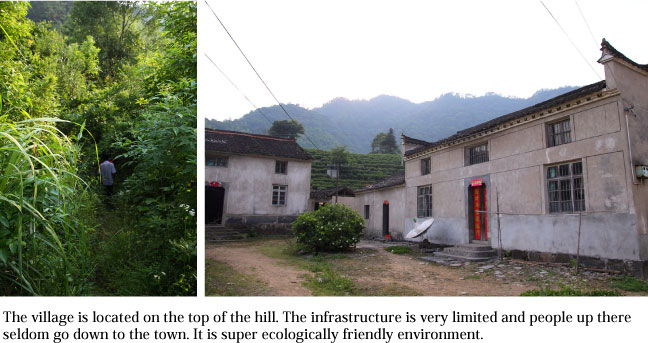
The production area of the real Taiping Houkui is limited to three villages only; namely, Hou-keng (猴坑 Monkey Pit) ,Hou-cun (猴村 Monkey Village) and Yan-jia (颜家 Yan Family). These three villages are located at Xin-ming Courtyard (新明乡 Xin-ming Xiang), at Huang-shan City (黄山市), Anhui Province (安徽省). The tea gardens are scattered around t the mountainous area. The present primitive forest is rich in decomposed soil and it consistently supplies minerals to ensure exuberant growth of tea plant naturally.
One of the essential factors for good green tea is its mellow taste. This taste originates from the amino acid called theanine. Young buds contain high level of theanine, but it is converted to polyphenol such as catechins when tea leaves receive sun light. On the other hand, less sunshine will maintain the high level of theanine in the leaves as bio-conversion does not effectively take place. The reason what makes the original Taiping Houkui very rich in amino acid is because of the high-elevated area which is often covered with fog which hinders direct sunlight on the leaves. In particular, Hou-keng is the best production area among the three places aforementioned thanks to its location which is facing to the north and slightly slanted to the East. The hillside is under shady area and protected from strong sunlight. In addition to the foggy condition, this shady location is favorable to reserve higher level of amino acid in tea leaves.
Besides, at high elevation, there is a huge temperature difference between daytime and nighttime. During the day, there is sufficient sun light and tea leaves vigorously produce plentiful of substances such as amino acid and carbohydrate, which are essential for the exclusive quality tea as well as the growth of tea leaves. At night, if the temperature is high, metabolism is continually taking place, and tea leaves will consume the substances that were produced during the day time. However, at high elevations, the lower atmospheric temperature at night causes the tea leaves to become less active and therefore these substances remain in the leaves.
With these factors, tea leaves which are very rich in these substances contribute significantly to the quality of tea.
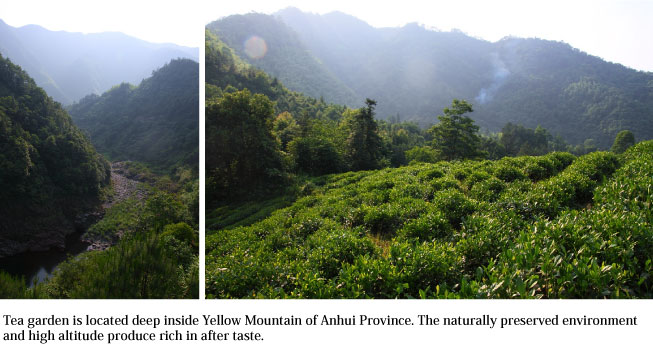
The local cultivar, called Shi-da Cultivar (柿大品种 Shi-da Pin-zhong) is carefully selected at Anhui Province, and seed breeding is carried out. This rare cultivar is specifically bred for this tea and not used for other types of tea product. The tea leaves are big, oval shaped, thick but soft and covered with a white down. The young leaves are pale green in color, but more mature leaves turn to dark green in color and are shinny, with uneven surface, and wavy edge. The bud grows up to 2 - 2.5cm (length).
Hand-plucking of tea leaves are carried out under extremely stringent regulations. The set criteria must be strictly followed based on the four principles as below:
In addition, the tea leaves that fall into following 11 criteria should not be plucked:
1) Tea leaves without bud on top,
2) Bud and leaf that is too small or too big,
3) Bud that is not straight,
4) Leaf that have grown and stretched excessively,
5) Bud and leaf which is not well-grown,
6) Found to be purple in color,
7) Looks very pale in color,
8) Skinny bud,
9) Bud damaged by plant disease,
10) The burl (叶节间 Ye-jie-jian) between leaf is too wide (as shown in the drawing below),
11) The tiny leaf attached to the bud, which indicates malnutrition is due to over-plucking or the first bud in spring comes with. Taiping Houkui must be made using the leaf with correct length, color, size and shape. Thus, any leaf which could not meet the aforementioned criteria must be discarded.
It is said that the best time to harvest the best quality tea leaves for Taiping Houkui is only 14 days in total throughout a year, which falls between Grain Rain (谷雨Gu-yu, the 6th Solar Term of the 24 Solar Terms of in traditional East Asian lunisolar calendars) until the beginning of summer (立夏 Li-xia, the 7th Solar Term). During summer, the lower grade of tea produced is called Jian-cha (尖茶).
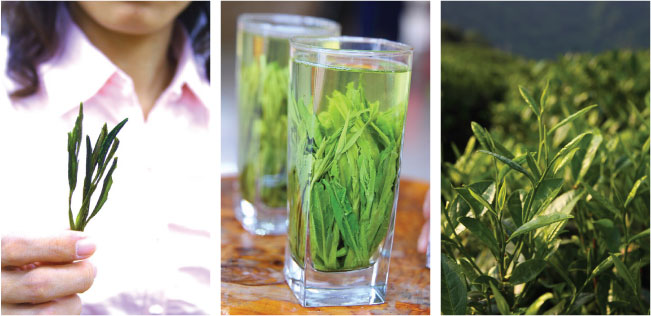

When all the tea leaves have been plucked, they are sent to the production area, the stringent picking is carried out to select every twig in a meticulous manner. The standard of picking is to select the twig (one twig = 1 bud and 3 leaves) which is robust and well grown, and from every twig, only one bud and two leaves remain – at 1/3 of the distance below the second leaf from bud, the third tea leaf is plucked and removed. The first and second tea leaf must be almost the same height as the bud on top, i.e. 6 cm in overall. In any event, one kilogram of product consists of 20,000 buds. In such a strict manner, the picked leaves with even length and appearance resemble the finest tea of its group (i.e. the sharp-shaped green tea 尖形绿茶 Jian-xing Lü-cha).
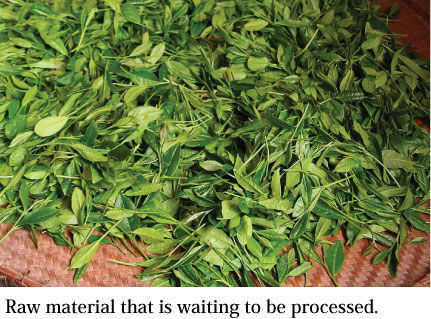
The purpose of 殺青 is to inactivate oxidative enzyme such as polyphenol oxidase (PPO) with heat.
Pan frying is literally frying tea leaves in a metal pan when the temperature of pan reaches 120 - 130˚C. With high temperature, it takes a very short time to heat the tea leaves and inactivate oxidative enzyme. In the production of other type of Chinese green tea, pan with sharp bottom base (尖底锅 Jian-di Guo) is prevalently used. This type of pan is suitable for the formation of tight and slender shape tea leaves while frying. In making Taiping Houkui, the distinctive appearance necessitated is rather rough (粗 Chu), loose (松 Song) and flat (扁平 Bian-ping). Thus, a deep flat bottom base pan (深底平锅 Shen-di Ping-guo) is used.
Beforehand, make sure the pan is thoroughly cleaned until smooth and shinny. When the temperature reached 120 - 130˚C, place about 75-100 g of tea leaves into the pan, and fry it for 3 – 4 minutes. With fingers slightly curved,lightly stir-up the tea leaves from bottom to edge of pan, then quiver for 2 – 3 times, and let the tea leaves evenly spread out and drop back into the pan. In every minute, fry and stir for about 30 times. After 3 – 4 minutes of frying, when the leaf turn soft while the edge of leaf is slightly crispy, leaf changes to dark green in color, loses it lustrous appearance, and begin to emit their own pleasant fragrance, this indicates the frying is sufficient. Thus, the tea leaves will be removed from the pan at once, and transferred to the bamboo plate and shiver for several times to cool down (散热 San-re) which will strengthen the tea leaves and allows vaporization (the moisture content of tea leaf is reduced to about 70%), and then immediately proceed for heating.
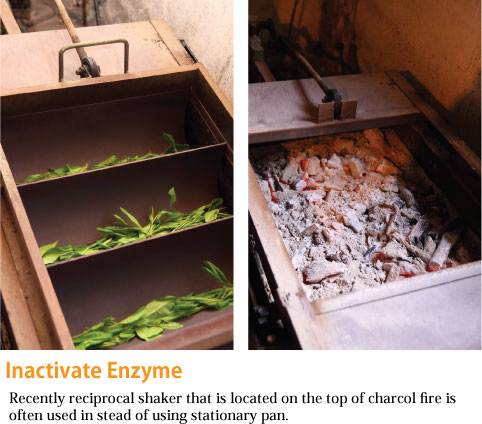
This is the most critical stage to form the acuminate-sharp shape of Taiping Houkui. Each pan of fried tea leaves will be served with four bamboo basket (烘笼 Hong-long) heated at different temperatures. The first bamboo basket is heated up to 110˚C, subsequently the following basket is heated to lower temperature progressively, i.e., 100˚C, 85˚C and 60˚C, respectively. The blanched tea leaves on the bamboo plate are placed on top of the first bamboo basket, and then lightly knock at the edge of bamboo plate to disperse the leaves over the plate and heat for 2-3 minutes. Then the leaves are transferred to the second bamboo basket and heated for 2-3 minutes. While tea leaves are still warm and soft, they are lightly pressed (捺压 Na-ya) using both palms that shape the leaves. Following that, they are again transferred to third bamboo basket and the same steps are repeated. When the leaves are transferred to the last bamboo basket and heated for 2-3 minutes, the moisture content of leaves are reduced to about 15%, and at this stage, the partially dried leaves harden and no pressing is applied as not to cause damage to the leaf. Overall, the first heating takes about 12 minutes.
Finally, the leaf is transferred to a bamboo plate for cooling (about 1 hour). The re-distribution of the moisture from the stem to surface leaf is underway; this conditions the leaves for the next stage of heating. The main purpose of the first heating is to vaporize moisture from the leaves as soon as possible, halt remnant enzyme activity, preserve the green color of leaves, and at the same time, forms the shape of Taiping Houkui.
About 4-5 plates of tea leaves from 1st heating are gathered together and proceed for the second heating. The temperature of bamboo basket (烘笼 Hong-long) is about 80˚C. After placing the tea leaves on the plate, lightly pat the plate several times, until all the leaves evenly settle on the plate, use palm to lightly press the leaves thoroughly; this is to strengthen all the leaves. Leaves have to be turned in every 5-6 minutes, repeated for 5-6 times, thus, the overall process takes about 25-30 minutes. Remove the leaves from the bamboo basket when the moisture content is reduced to about 10%. Before proceeding to the next heating, the leaves would be left on the bamboo plate for cooling down. It takes 5-6 hours to re-distribute the moisture.
After sufficient cooling, the leaves (0.5 – 1 kg) will be placed on top of bamboo basket for the 3rd heating at 60˚C. Again, tea leaves have to be turned in every 5 minutes, repeated for 6 times, thus, the overall process takes about 30 minutes. During the heating with Wen-huo (文火, mean smoldering fire), lower temperature used generates identical fragrance called清香 (Qing-xiang, means greenish refreshing flavor).
After the moisture content is further reduced to 5-6%, the tea leaves will be removed from the bamboo basket, and left on a bamboo plate to cool down (0.5 – 1 hour), and then packed.
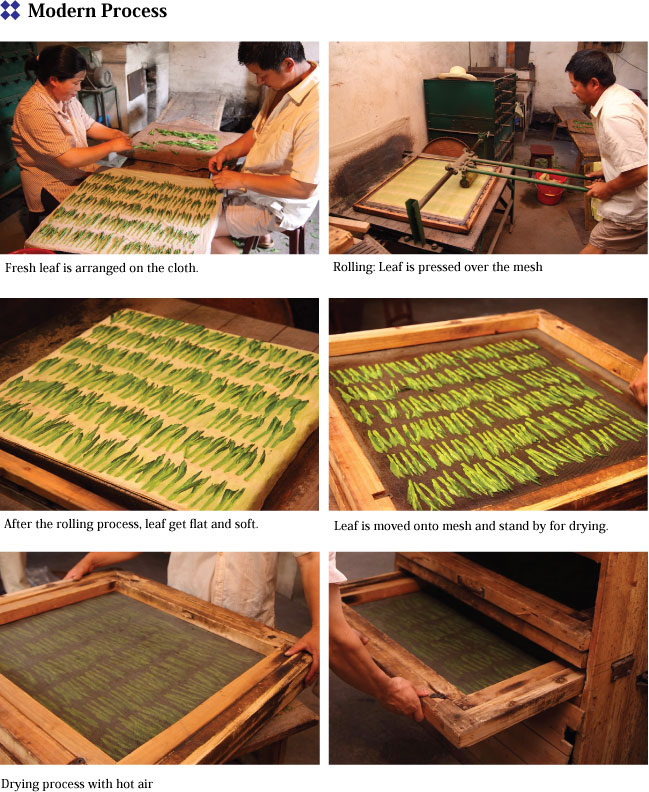
Leaf is fleshy, thick, robust, straight with tips, not in a loose manner, not curled and not curved. The real Taiping Houkui must consist of twigs whereby each twig is made of one bud embraced by two leaves, and naturally stretched. For poorer quality, the tea contains single leaf where bud is missing. This is not the real Taiping Houkui but the Hou-jian (猴尖) which is made from the 3rd and/or 4th leaf that left-over after the picking of bud and first 1-2 leaves for making a Houkui. Poor quality tea is mixed with broad strips of leaves. Some leaves are ‘chopped’ and without tips. As compare to good quality leaf, the leaf of poorer quality often over-pressed and twisted out of its normal leafy shape and appearance.
The real Taiping Houkui is in pale green color, even, bright and lustrous. Leaf is covered with a very fine white down and closely well set to leaf and hidden; it is not easily seen and will unfurl when brewed. Poor quality tea is in either very light shinny green or dark green color, with lots of down that is outstretched and clearly seen.
The good quality tea consists of dry leaf in regular shape. Poor quality tea contains a lot of broken pieces. It is a mixture of various sizes and shapes. Leaf is not in the whole twig form where bud and leaf and is well attached, but contains crushed and individual leaves. The color is a mixture of yellowish green or dark green color.
The well-made tea must be free from extraneous matter such as fiber, bamboo or wooden flakes, sand or stone, dust.
When brewed, the liquor gives a long-lasting flavor with orchid scent, especially on the first brewing.
Bright, clear and transparent, with very light yellowish green color.
The tea gives fresh green note, refreshing, smooth, mellow and sweet after taste.
The brewed leaves show a fresh, bright and even green in color. When touched with finger, the leaves are thick but soft and elastic. The thin red line is seen at the main leaf vein which indicates the tea is made from the real Taiping Houkui cultivar. If it is of poor quality, the leaves are either yellowish green or dark green in color, with a dull appearance. When touched, the leaves are thin and stiff.
The genuine Taiping Houkui produced in a restricted manner at three main villages’ area: Hou-keng (猴坑 Monkey Pit) ,Hou-cun (猴村 Monkey Village) and Yan-jia (颜家 Yan Family). Other than these areas, there are several places which produced similar types, called Hou-jian (猴尖), but there is a slight differences as shown in table below:
Characteristic |
Taiping Houkui (猴魁) |
Taiping Hou-jian (猴尖) from other places |
Color |
Pale green, and lasts during storage |
Shinny fresh green, color does not last. |
Down |
Hidden, exteriorly. The down is not clearly seen on dry leaf. It is seen only when the leaf is brewed and unfold in boiled water. |
Very obviously seen on dry leaf. |
Leaves and Bud |
Very fleshy, thick, robust |
Very light & thin |
Flavor and Taste |
Strong flavor with mellow taste |
Mild flavor, mild taste |
Brewed Leaf |
Fleshy, soft, yellowish green, glossy |
Pale & thin |
In you are using tap water, it is necessary to filter the water using an activated carbon filter. If not, you wouldn’t be able to enjoy the authentic taste of tea. Chlorine is added to tap water in order to sanitize bacteria. This chlorinated water will also harm our body cells. Concerning about our health condition, it is very important to remove chlorine from drinking water. The most effective method in removing chlorine is to install an activated carbon filter. This type of filter is designed for removing organic substance. It will remove not only chlorine, but also other harmful substance such as contaminated pesticide. The activated carbon filter can be easily obtained from the common hardware shop in most countries. If activated carbon filter is not available, please place a charcoal inside the water and leave it for over night. The material composed of activated carbon filter is made of ground charcoal. The difference is that activated carbon filter contains much finer particles and hence it has extremely large surface area for a better efficiency in filtration. We do not suggest RO water (reversed osmosis water) or distilled water. This water carries no mineral, the taste and flavor of tea tends to be very unstable, unless you have very superior quality tea and tea equipment.
In the long run, you may observe a thick layer of scale accumulated inside your kettle. Our mother usually taught us to wash and remove it with citric acid. But please do not even try to remove the scale. Scale consists of minerals that exist in the water. The mineral composition is reflected from the water you used. If you remove the scale, the mineral ion balance between scale and water is destroyed. This balance is called buffer effect in science. The flavor and taste will seriously run out and you won’t be able to get previous taste and flavor for a long time. It is also important to stick to the same type of water whenever brewing tea. If source of water is changed, it carries different type of minerals. It will affect the mineral ion balance too.
Go to further information about suitable water for brewing tea >>
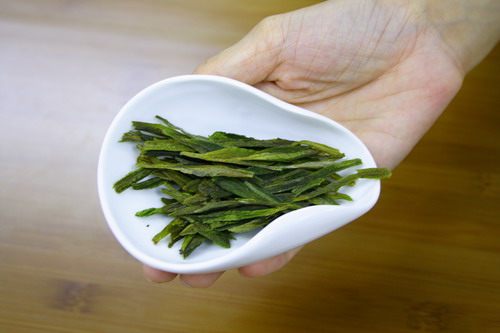
Prepare 3 g of tea leaves for 150ml of water.
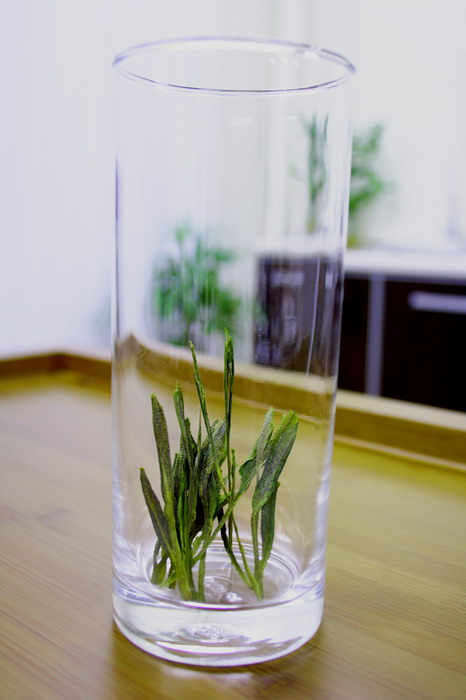
Place the tea leaves into a warmed glass. One could take a sniff to smell the orchid fragrance of leaf liberated by the heat from warmed glass.
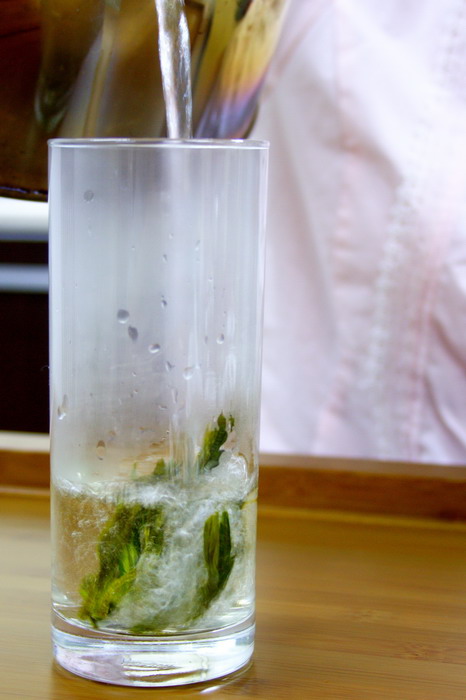
Let the boiled water to cool down to 85-90˚C. Green tea leaves prefer a slightly cooler temperature. Gently pour water onto the leaves. The quantity of water should be 1/3 of glass (about 50 ml), or completely immersing all tea leaves.

After 1minutes, pour in another 100 ml of water. Brew for 2 minutes and serve.*
Taiping Houkui is only lightly pressed during the process. Therefore, it has to be brewed longer in favor of effective extraction of substances from leaf.
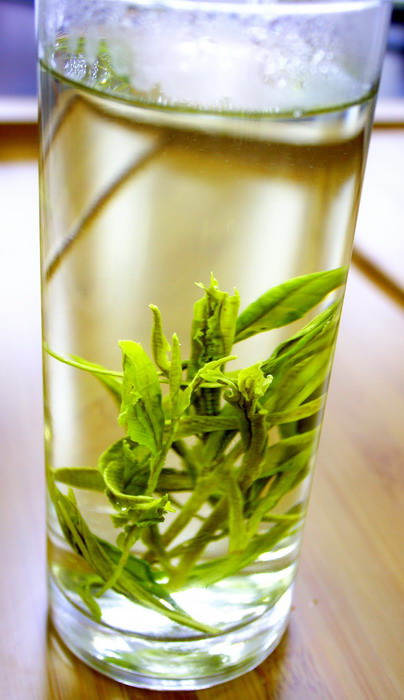
If the taste is too strong, add boiled water to the glass.

This tea can be brewed 4 times. In general, enjoy the pleasure of orchid fragrance when firstly brewed; for second brewing, enjoy the mellow taste. The following third and fourth brewing look for the delicate fragrance that remains.
There is another way to enjoy Taiping Houkui. When the liquor of previous brewing is left to about 1/3 in the glass, pour in another 100 ml of boiled water (at 85-90˚C). Brew for 5 minutes and it is ready. In such a way, the taste is not diluted too much for subsequent brewing up to 4 times.
* If tea is not served at once, tea leaves must be filtered well and kept without water. Place a tea strainer on top of the cup before pouring the tea into the cup. This is to avoid the liquor becoming bitter and stewed. Besides, it prevents tea leaves from being over cooked. In addition, tea after filtration will be ready for second brewing.
Once a bag of tea is opened, please finish it within 3 months if you wish to enjoy its freshness. From the medical point of view, it is safe to consume the tea even if it is kept for a few years. However the freshness disappears if it is kept for too long. Tea must be tightly sealed before it is kept. Tea should be kept in ambient and dry conditions such as in the living room, but it must be completely away from humidity. Tea should not be kept in the kitchen as the environment is very humid. Avoid enclosed area such as inside the cupboard or drawer as these places are damp. Also avoid opening the bag of tea in humid atmosphere. It is recommended to open the bag during a sunny day or under air-conditioned atmosphere. Once tea leaves absorb moisture, deterioration of tea will be triggered within a few days. Tea will then give an astringent taste, sometime it tastes sour. The fresh aroma also becomes weaker.
The quality of tea lasts longer if it is kept in the fridge. However we strongly recommend you not to keep tea in the fridge. When tea is withdrawn from the fridge, there is usually condensation. Once tea is exposed to moisture during condensation, the quality will deteriorate within a few days. The higher moisture content in the tea leaves will trigger oxidation and it will completely destroy the quality of tea.
Here’s one frequently asked question: what happens if bag is sealed using tape or tea is packed in zipper bag and kept inside the fridge?
For your information, these simple sealing methods are not sufficient. When the bag is withdrawn from the fridge, it is cold inside the bag and therefore causes negative pressure. Air will be drawn from outside and condensation will occur. In addition, if the bag is taken in and out from the fridge very often, this will cause heat stress to the tea leaves as temperature is increased and decreased very frequently. If tea is kept in the fridge, when it is withdrawn from the fridge, it is necessary to leave it in ambient atmosphere for more than 24 hours in order to warm up the tea leaves. Based on our experience, 12 hours is not long enough. We may think tea is warmed up, but inside the bag, the tea leaves are still cold due to insulation effect.

Please feel free to send us e-mail for enquiry at:

 |
We accept various kinds of credit card through Paypal.
Only if customer prefer other option of payment, we suggest "Bank Transfer".
Various choice of shipping method
EMS, SAL, Small Packet, Small Packet (SAL) Yamato Express and Surface
For shipping tea, we usually suggest small air parcel, the estimated shipping cost of tea in 100g (with wrapping material ) is
Small Parcel
USA JPY 600, EU JPY600 and Asia JPY470
Small Packet (SAL)
USA JPY380, EU JPY380 and Asia JPY320
The shipping fee to oversea by small air parcel happens to be even cheaper than domestic shipping fee in Japan.
For your information, some countries, EU in particular imposes custom duty. We need buyer to bare the duty. We are sorry, but we cannot change the amount on the invoice, and we do not mark any packages as gifts. We will strictly follow the custom regulation.